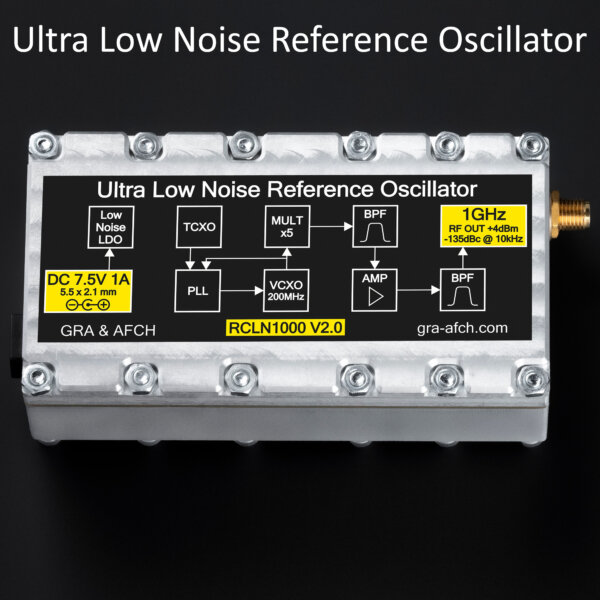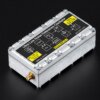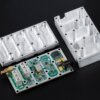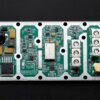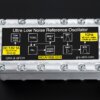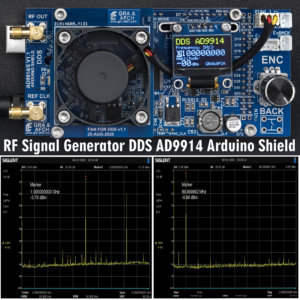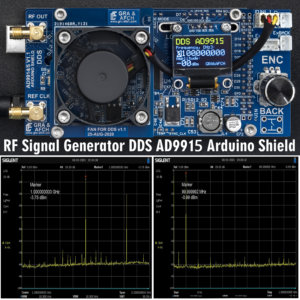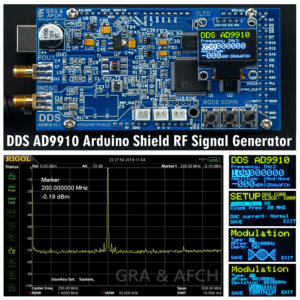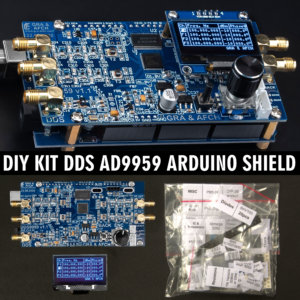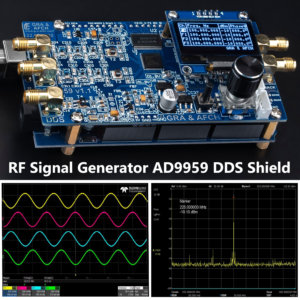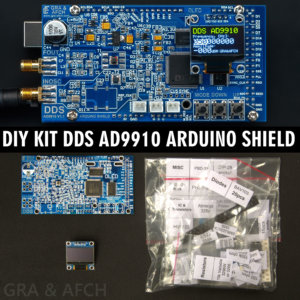1GHz Ultra Low Noise Reference Oscillator -131 dBc/Hz @ 10kHz RCLN1000 for AD9910 AD9912 Units
Units Sold: 11
Ultra Low Noise Reference Oscillator RCLN1000
Reference Oscillator for DDS AD9910 DDS AD9912 Units
PCB Design Schematics Case and Software made by GRA & AFCH
$199.95 – $299.95
1GHz Ultra Low Noise Reference Oscillator -130dBc/Hz @ 10kHz RCLN1000 for DDS AD9910 DDS9912 Units
Ultra Low Noise Reference Oscillator RCLN1000
Reference Oscillator for DDS AD9910 DDS AD9912 Units
PCB Design Schematics Case and Software made by GRA & AFCH
Ultra Low Noise Reference Oscillator
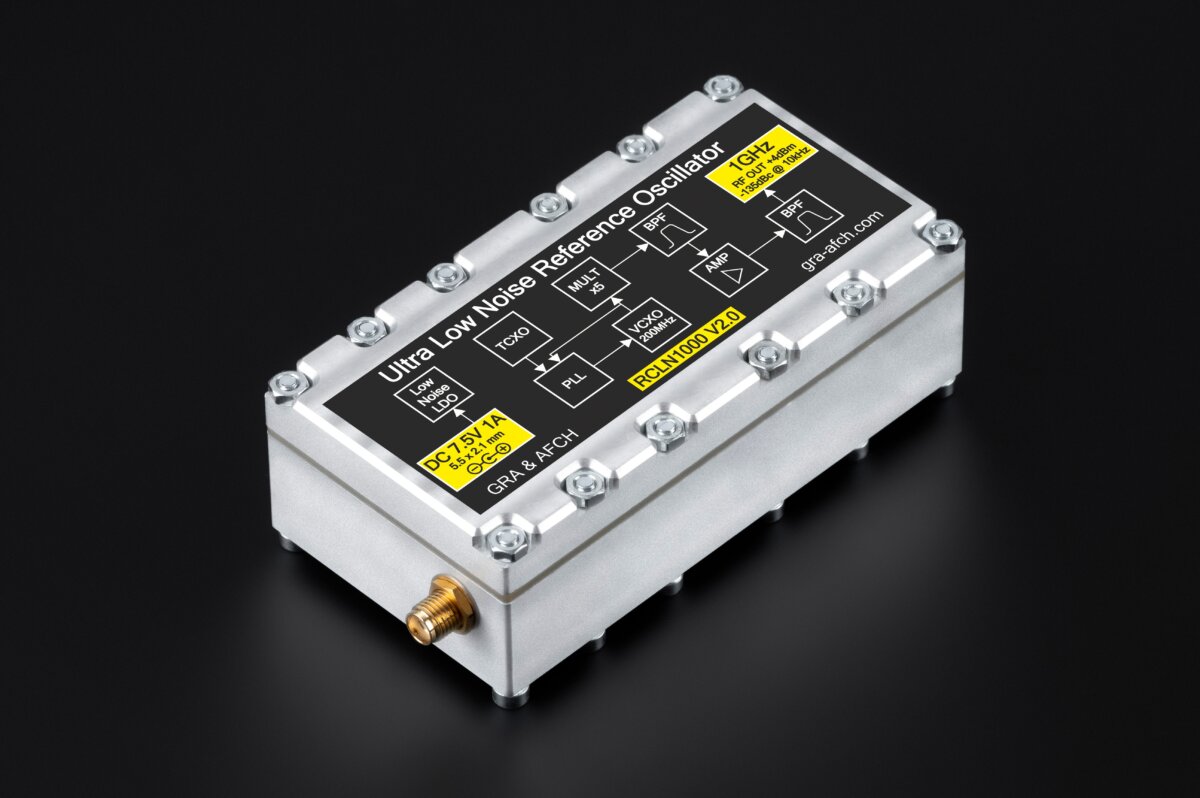
Listing includes:
- Ultra Low Noise Reference Oscillator
- Aluminum Case (optional, choose in selector)
If you have ANY questions, PLEASE ASK us.
Short description:
The output signal quality of a DSS (Direct Digital Synthesizer) dependent upon the Signal quality of the reference clock that is driving the DDS
This is why it is very important to select a low noise 1GHz clock source for the AD9910 and AD9912 DDS RF Units
It is essential to use the Ultra Low Noise Reference Oscillator get better performance than the PLL’s built-in frequency multiplier
Important quality aspects of the clock source, such as phase noise (in dBc/Hz) and frequency stability (in PPM) are reflected in the DDS Units output
Overview:
Model RCLN1000 v2.0 is an ultra-low phase noise 1 GHz clock oscillator, temperature compensated with true sinewave output.
Low cost, low phase noise, high temperature stability and excellent noise immunity performance due to the thick aluminum housing.
This makes this device an excellent choice over competing offerings.
Features:
- 1 GHz Fixed Frequency
- Ultra-Low Phase Noise: -131 dBc/Hz @10 kHz
- Excellent Spurious suppression: < -85 dBc
- Output Power: +4 dBm
- Supply Voltage: 7.5 VDC
- Supply Current: 200 mA
- Operating Temperature: 0°C to +70°C
- Frequency Stability (0-70°С): ±2 ppm (±2 kHz)
- Stability per degree: 0.06 ppm/°C (57 Hz/°C)
- Case Material: Aluminum
- Dimensions: 95х50х40 mm
- Weight: 300 g
- Power Connector: 5.5×2.1 mm (+ in center)
- RF Connector: SMA
Applications:
- Frequency Synthesizers (DDS)
- Local Oscillator
- Receivers
- Wireless Communications
- SATCOM
- Optical Communications
Description:
The basis of this oscillator is a custom 200MHz VCXO (Voltage Controlled Crystal Oscillator) with low phase noise of -150 dBc @ 10kHz offset.
To stabilize the VCXO frequency over the entire operating temperature range, a TCXO is used with the application of feedback using PLL (Phase Locked Loop) technology.
To convert the stabilized frequency from 200 MHz to 1 GHz, a frequency multiplier by 5 is used.
And to suppress unwanted harmonics and subharmonics, a set of filters used.
They consisting of 2 sections of Helical Band Pass Filter (BPF), ceramic High Pass Filter (HPF) and Low Pass Filter (LPF) is used.
To amplify the output signal to the level of +4 dBm, a low-noise RF Monolithic Amplifier is installed between the BPF filters.
To reduce the mutual influence of internal blocks on each other, besides inter-block aluminum partitions, 4 separate power lines are used.
Each of these lines are stabilized by a low-dropout regulator (LDO) with low phase noise.
The block diagram of this generator is as follows:

A thick-walled monolithic aluminum casing, made by milling, is used to shield the generator board.
Such a casing design is excellently shields the device from external sources of interference.
It is also significantly reduces electromagnetic emissions originating from the generator components.
Hardware Features:
- 1 GHz Fixed Frequency
- Ultra-Low Phase Noise: -130 dBc/Hz @10 kHz
- Excellent Spurious suppression: < -85 dBc
- Output Power: +4 dBm
- Supply Voltage: 7.5 VDC
- Supply Current: 200 mA
- Operating Temperature: 0°C to +70°C
- Frequency Stability (0-70°С): ±2 ppm (±2 kHz)
- Stability per degree: 0.06 ppm/°C (57 Hz/°C)
- Case Material: Aluminum
- Dimensions: 95х50х40 mm
- Weight: 300 g
- Power Connector: 5.5×2.1 mm (+ in center)
- RF Connector: SMA
Phase Noise:
To calculate the theoretical phase noise at the generator output (NFout), the following expression should be used:
NFout = NF_VCXO + 20log(Fout/Fin) + NF_amp + NF_other, where:
NF_VCXO – phase noise of the VCXO = -150 dBc/Hz @ 10 kHz offset
Fout – output frequency of the RCLN1000 = 1000 MHz
Fin – input frequency (from VCXO) = 200 MHz
NF_amp – phase noise of the RF amplifier = 3 dBc/Hz
NF_other – phase noise of other components = 2 dBc/Hz
That is, NFout = -150 + 20log(1000/200) + 3 + 2 ≈ -150 + 14 + 3 + 2 ≈ -131 dBc/Hz @ 10 kHz offset
Actual phase noise measurements were conducted using the Anritsu MS2781B instrument and demonstrated that the phase noise level is significantly below -118 dBc/Hz at a 10 kHz offset, which represents the measurement limit for the MS2781B device. This is why, at the final stage of development, we had to employ a different instrument – the PN2060C, which allowed us to measure the actual phase noise of our generator at -131 dBm with a 10 kHz offset, precisely matching our calculated value.

RCLN1000 Low Noise Oscillator PHASE NOISE FigureThese types of generators are most often used with a Direct Digital Synthesizer (DDS, for instance, such as AD9910, AD9912, AD9914).
It’s worth saying a few words about the importance of using a low-noise clock source instead of the built-in frequency multiplier on a PLL specifically for such synthesizers.
The output signal quality of a DSS is dependent upon the signal quality of the reference clock that is driving the DDS.
Important quality aspects of the clock source, such as phase noise (in dBc/Hz) and frequency stability (in PPM) and will be reflected in the DDS output.
DDS Output dependency of the Clock Source:
Below is an illustration explaining the dependency of the DDS output signal quality on the quality of the clock source:

Spectrograms:
The spectrogram of the RCLN1000 at a 10 MHz Span:
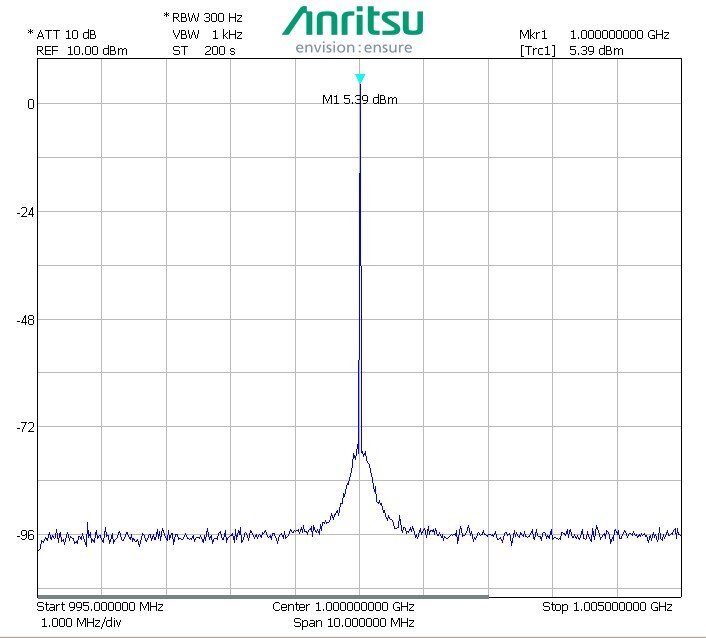
The spectrogram of the RCLN1000 at a 4 GHz Span:
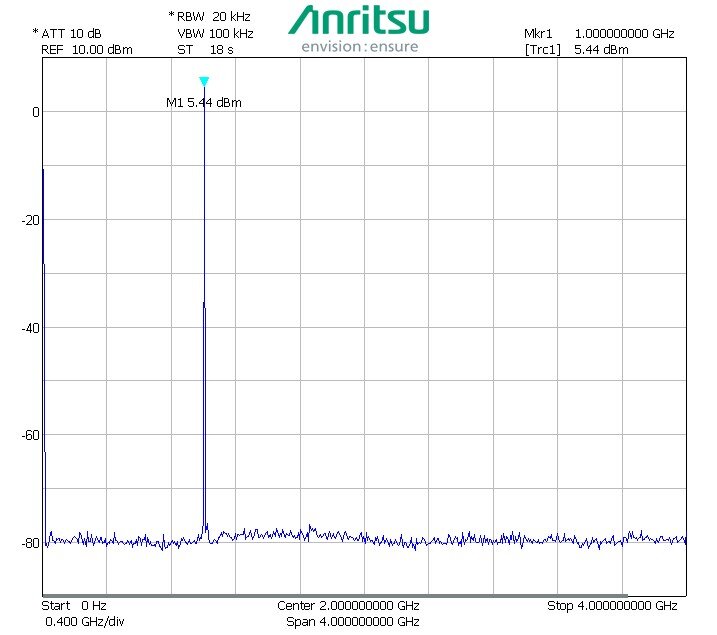
Applications:
Telecommunications:
Low phase noise generators are very important for modern telecommunication systems.
They provide signal stability and accuracy under the conditions of transmitting large volumes of data.
In mobile networks and fiberoptic communication systems frequency control accuracy is needed to prevent interference and ensure high data transmission speeds.
Low phase noise allows for improved communication quality, especially in the high-frequency range, where interference can be particularly noticeable.
Radio Astronomy:
In radio astronomy low phase noise generators are used in radio telescopes to enhance the quality of observations.
This allows for improved accuracy of measurements and the quality of the obtained data.
They are also used in complex systems, such as interferometers, where signals from different antennas need to be precisely synchronized.
Radar:
In radar systems low phase noise generators allow for improved accuracy in determining the distance to objects.
The accuracy of frequency, as well as stability and low noise level, are important when locating objects.
Lower phase noise can lead to more accurate location and identification of objects, especially at long distances.
Ultra Low Noise Reference Oscillator by GRA & AFCH
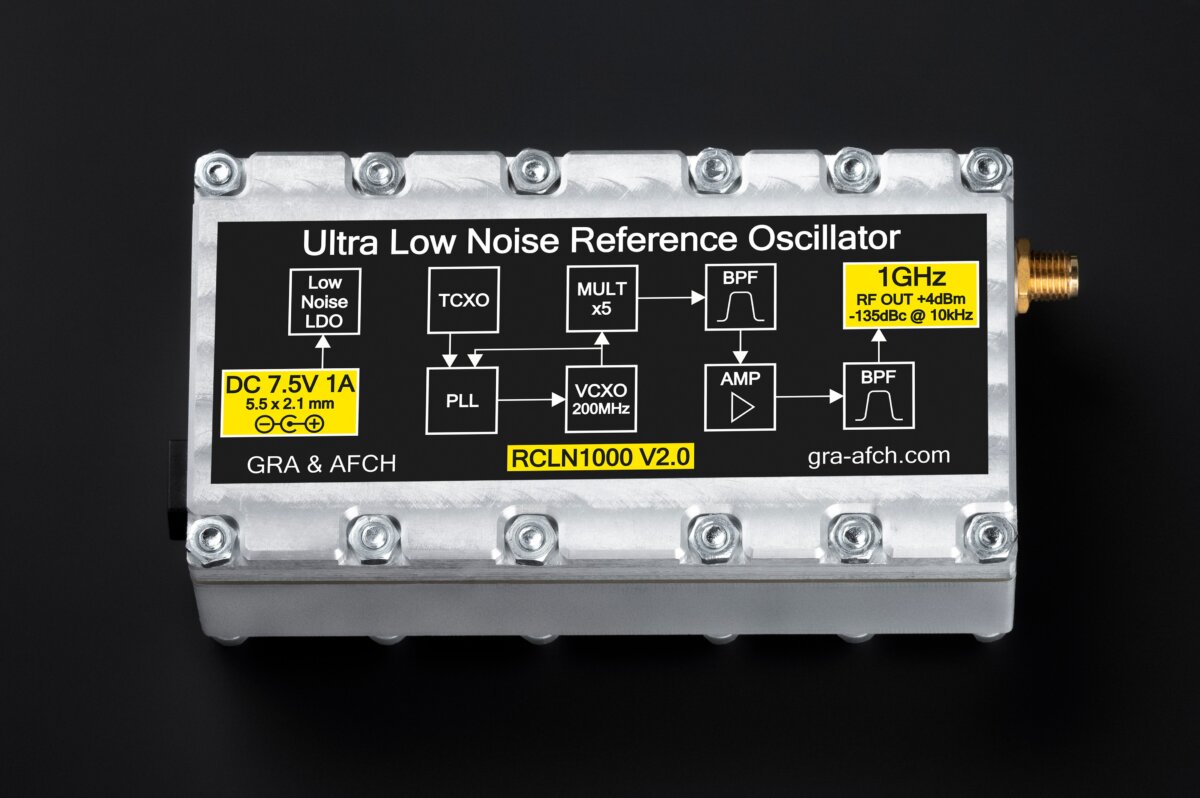


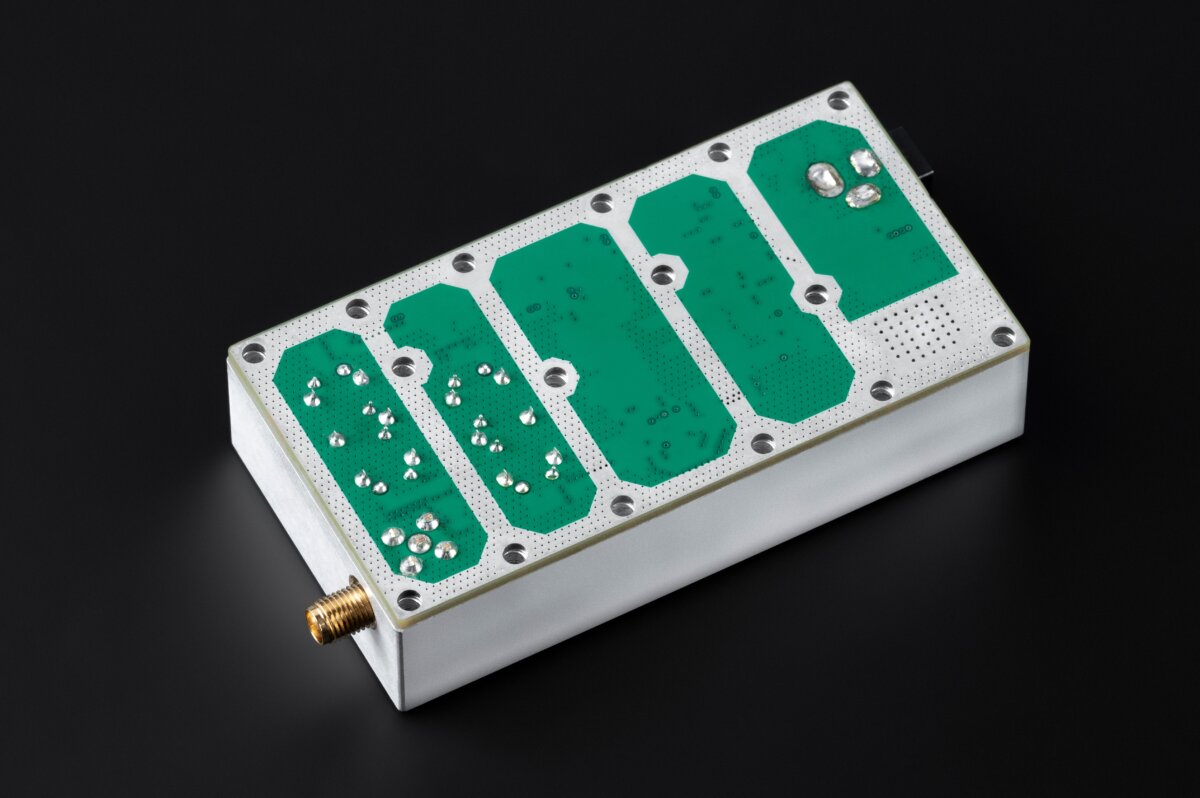
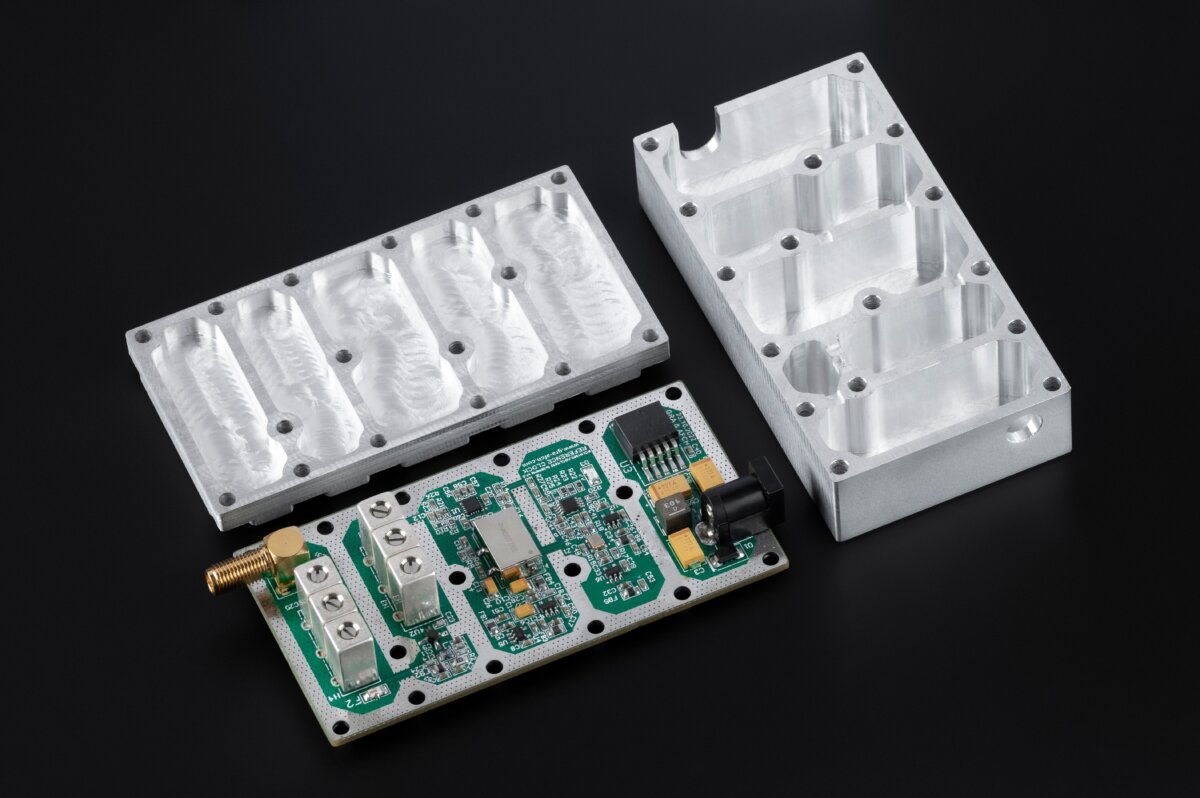
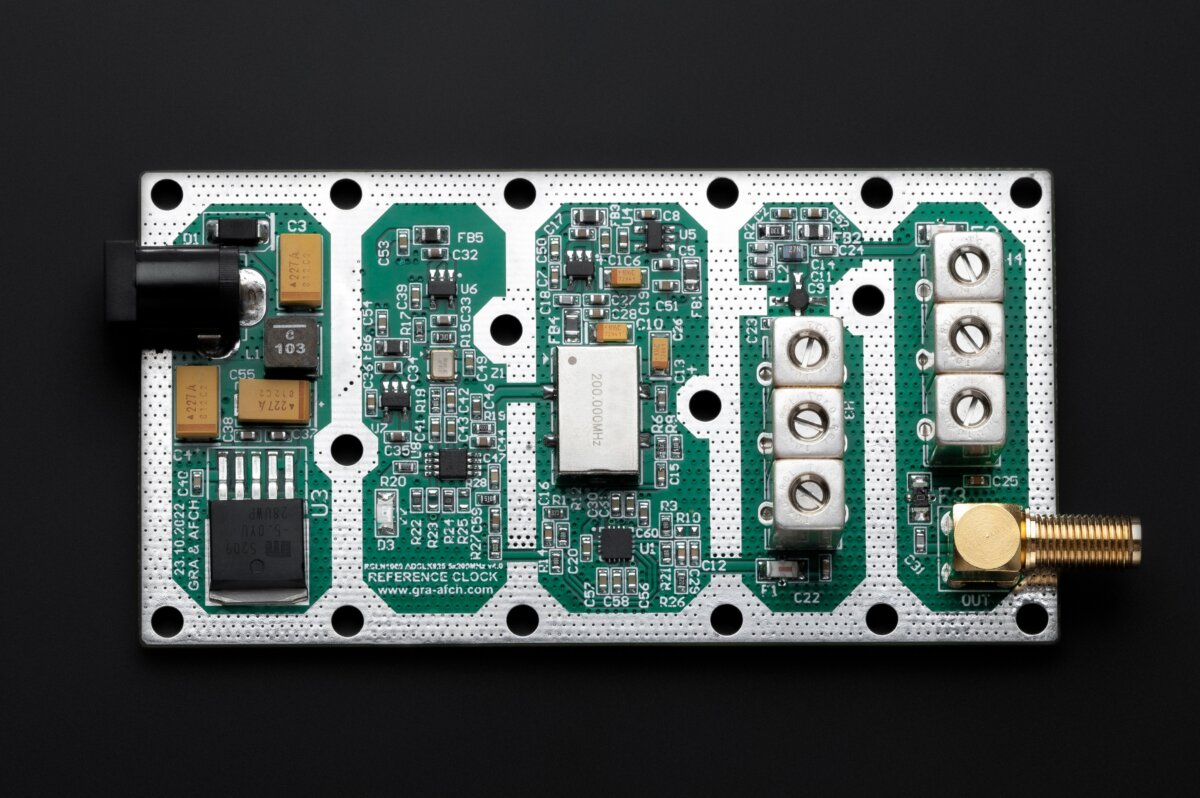
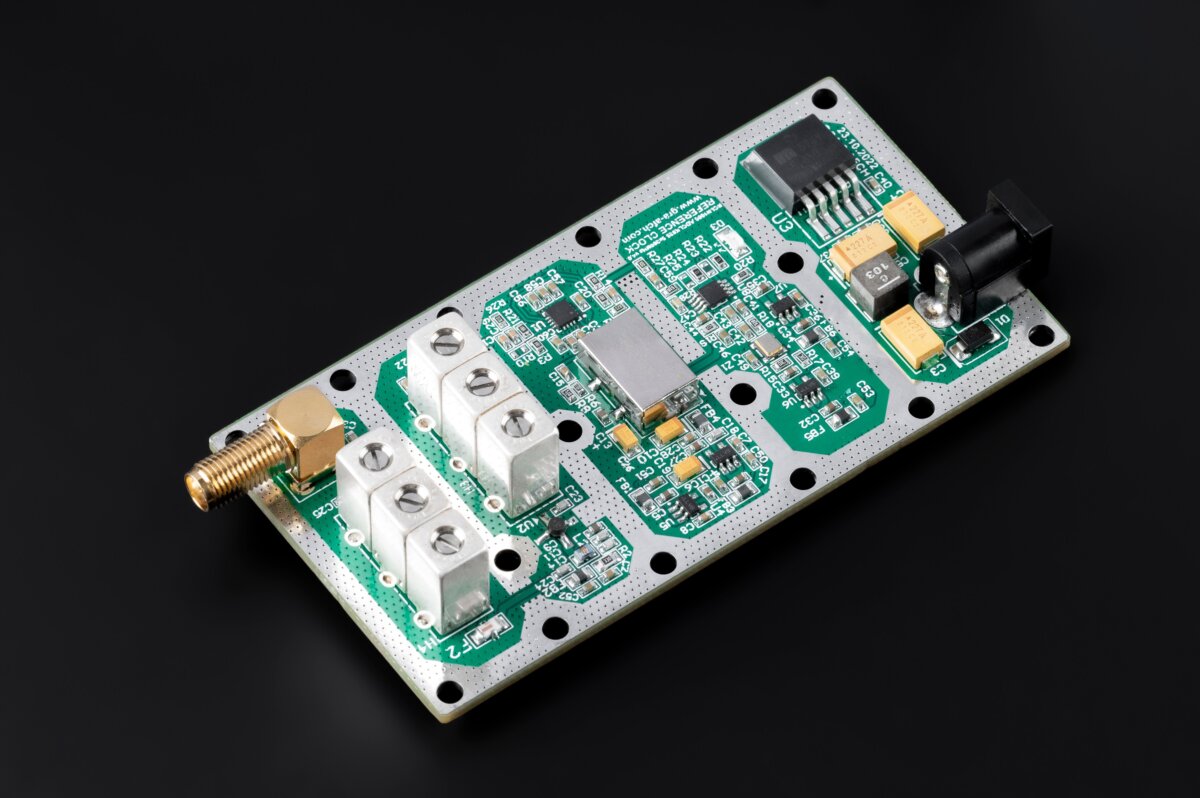
Ultra Low Noise Reference Oscillator by GRA & AFCH:
If you have ANY questions, PLEASE ASK us.
Shipping and Return information
All Items are shipped from Ukraine
Via International registered Airmail
Shipments are made within 1 business day
After the payments are received and verified
It takes about 4-7 days via UPS Express delivery
It takes about 10-18 days via Standard shipping
It takes about 35-45 days via Economy shipping
We combine multiple Items to save on shipping
UPS Express Shipping time (recommended):
| Europe: | 3-5 days |
| Germany: | 3-5 days |
| USA, Canada: | 4-7 days |
| Asia, South America: | 5-7 days |
| Australia, New Zealand: | 5-7 days |
| Africa, Central America: | 5-7 days |
Standard Shipping time:
| Europe: | 10-12 days |
| Germany: | 10-12 days |
| USA, Canada: | 10-15 days |
| Asia, South America: | 10-18 days |
| Australia, New Zealand: | 12-18 days |
| Africa, Central America: | 12-18 days |
Economy Shipping time:
| Europe: | 25-30 days |
| Germany: | 25-30 days |
| USA, Canada: | 30-35 days |
| Asia, South America: | 35-45 days |
| Australia, New Zealand: | 45-55 days |
| Africa, Central America: | 45-55 days |
Return Policy
All Returns are accepted
- For Return you should contact Us within 14 Days after receiving the Item
- Refunds are made as Money back or Replacements (buyer’s choice)
- Return Shipments are paid by the buyer
- No restocking fees are charged
Customs Policy
We as a seller do not receive from the buyer any charges any sales taxes and handling fees.
In any case we are not responsible for Tax(VAT) or any other Import duties or any other equivalent fees that arises upon delivery.
Please consult with your local Customs legislation and visit your local Customs department or website before making any purchases.
You may also like…
DDS AD9914 Arduino Shield RF Signal Generator [1.4GHz @3.5GHz Core Clock, Low Spurs, Low Harmonic]
DDS (Direct Digital Synthesis) Analog Devices AD9914
Arduino Shield Easy connection to Arduino MEGA 2560 without additional wires and converters
All functions of the DDS AD9914 are brought to the contacts of the Arduino MEGA
With this you can fully reveal all the capabilities of the DDS AD9914 Shield
PCB, Design, Schematics, Case and Software made by GRA & AFCH$699.95 – $769.95 Select optionsDDS AD9915 Arduino Shield RF Signal Generator [1GHz @3GHz Core Clock, Low Spurs, Low Harmonic]
DDS (Direct Digital Synthesis) Analog Devices AD9915
Arduino Shield Easy connection to Arduino MEGA 2560 without additional wires and converters
All functions of the DDS AD9915 are brought to the contacts of the Arduino MEGA
With this you can fully reveal all the capabilities of the DDS AD9915 Shield
PCB, Design, Schematics, Case and Software made by GRA & AFCH$599.95 – $669.95 Select optionsLow-Pass Filter LPF 7th Order Elliptical 1-1000Mhz 3.5, 7, 14, 28, 144, 433MHz etc for RF Amlifier, Receiver, Transmitter, Mixer, Transceiver, Antenna.
Low-pass filter is a filter that passes signals with a frequency lower than a selected cutoff frequency and attenuates signals with frequencies higher than the cutoff frequency. These filters are usually applied after RF amplifiers (MMIC, Gain-block and Class C amplifiers) for suppression of high-order harmonics of radio-frequency signals, or placed at the mixer output to filter out high-frequency interference that plays a role in frequency selection.
$18.95 – $69.95 Select optionsDDS AD9910 Shield for Arduino RF Signal Generator AM/FM/SWEEP [600 MHz, @1.5 GHz Core Clock, Low Spurs, Low Harmonic]
DDS (Direct Digital Synthesis) Analog Devices AD9910 Shield for Arduino
This device is designed to ensure seamless integration with Arduino MEGA 2560
It does not require any extra wires or converters to work properly
For maximum performance we recommend Ultra-low noise reference oscillator RCLN1000
All functions of the DDS AD9910 are brought to the contacts from the Arduino MEGA
With this you can fully reveal all the capabilities of the DDS AD9910 Shield
PCB Design Schematics Case and Software made by GRA & AFCH$199.95 – $264.95 Select optionsDIY KIT for DDS AD9959 Arduino Shield RF Signal Generator 4 Synchronized DDS Channels [225MHz, @600 MHz Core Clock, Low Spurs, Low Harmonic]
DIY KIT for DDS (Direct Digital Synthesis) Analog Devices AD9959 4 Synchronized DDS Channels
Arduino Shield Easy connection to Arduino MEGA 2560 without additional wires and converters
All functions of the DDS AD9959 are brought to the contacts of the Arduino MEGA
With this you can fully reveal all the capabilities of the DDS AD9959 Shield
PCB, Design, Schematics, Case and Software made by GRA & AFCH$189.95 – $249.95 Select optionsDDS AD9959 Arduino Shield RF Signal Generator 4 Synchronized DDS Channels [225MHz, @600 MHz Core Clock, Low Spurs, Low Harmonic]
DDS (Direct Digital Synthesis) Analog Devices AD9959 4 Synchronized DDS Channels
Arduino Shield Easy connection to Arduino MEGA 2560 without additional wires and converters
All functions of the DDS AD9959 are brought to the contacts of the Arduino MEGA
With this you can fully reveal all the capabilities of the DDS AD9959 Shield
PCB, Design, Schematics, Case and Software made by GRA & AFCH$189.95 – $234.95 Select optionsDIY KIT for DDS AD9910 Shield for Arduino RF Signal Generator AM/FM/SWEEP [600 MHz, @1.5 GHz Core Clock, Low Spurs, Low Harmonic]
DIY KIT for DDS (Direct Digital Synthesis) Analog Devices AD9910 Arduino Shield
Easy connection to Arduino MEGA 2560 without additional wires and converters
For maximum performance we recommend Ultra-low noise reference oscillator RCLN1000
All functions of the DDS AD9910 are brought to the contacts of the Arduino MEGA
With this you can fully reveal all the capabilities of the DDS AD9910 Shield
PCB Design Schematics Case and Software made by GRA & AFCH$189.95 – $254.95 Select options


